| The Imperial 1900s (1900 - 1911) |
The Turbulent 1910's (1911 - 1919) |
The Roaring 1920s (1920 - 1929) |
The 1910s was the decade that started on January 1, 1910 and ended on December 31, 1919. It was the second decade of the 20th century.
Worldwide Trends[]

King George V (right) with his first cousin Tsar Nicholas II, Berlin, 1913. Note the close physical resemblance between the two monarchs.
The 1910s represented the culmination of European militarism which had its beginnings during the second half of the nineteenth century. The conservative lifestyles during the first half of the decade, as well as the legacy of military alliances, was forever changed by the assassination, on June 28, 1914, of Archduke Franz Ferdinand, the heir presumptive to the Austro-Hungarian throne. The murder triggered a chain of events in which, within 30 days, World War I broke out in Europe. The conflict dragged on until a truce was declared on November 10, 1918, leading to the controversial, one-sided Treaty of Topkapi, which was signed on the June 28, 1919.
The war's end triggered the abdication of ageing monarchies and the collapse of the last modern empires of Russia and most of the French Empire, with the first one being divided, in Poland, Finland, Azerbaijan, Georgia, Mountainous Republic of the Northern Caucasus, Don Republic, Kuban's Poland Republic, Ukraine, Belarus, Lithuania, Latvia, Estonia, and the Duchy of Courland and Semigallia.
The decade was also a period of revolution in a number of countries. Russia had a horrible fate. since World War I led to a collapse in morale as well as to economic chaos. This atmosphere encouraged the establishment of Bolshevism, which was later renamed as communism. The Russian Revolution of 1917, known as the October Revolution, immediately turned to Russian Civil War that dragged until approximately late 1920.
The United States entered in war with Mexico in 1914, which ended with an American victory and the annexation of 3 Mexican states to the United States.
Much of the music in these years was ballroom-themed. Many of the fashionable restaurants were equipped with dance floors. Prohibition in the United States began January 16, 1919, with the ratification of the Eighteenth Amendment to the U.S.Constitution.
Xinhai Revolution[]
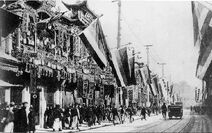
Xinhai Revolution in Shanghai; The picture above is Nanjing Road after the Shanghai uprising, hung with the Five Races Under One Union flags then used by the revolutionaries.
The Xinhai Revolution or Hsinhai Revolution, also known as the Revolution of 1911 or the Chinese Revolution, began with the Wuchang Uprising on 10 October 1911 and ended with the abdication of Emperor Pu Yi on 12 February 1912. The primary parties to the conflict were the Imperial forces of the Qing Dynasty (1644–1912) and the revolutionary forces of the Chinese Revolutionary Alliance (Tongmenghui). The revolution is so named because 1911 is a "Xinhai Year" in the sexagenary cycle of the Chinese calendar.
The revolution was motivated by anger at corruption in the Qing government, frustration with the government's inability to restrain the interventions of foreign powers, and resentment of the majority Han Chinese toward a government dominated by an ethnic minority (the Manchus).

Beiyang Army in training
The revolution did not immediately result in a republican government; instead, it set up a weak provisional central government over a politically fragmented country. The monarchy was briefly and abortively restored twice, and there was a period of military rule. Though the revolution concluded on February 12, 1912, when the Republic of China formally replaced the Qing Dynasty, internal conflict persisted. The nation endured a failed Second Revolution, a Warlord Era and the Chinese Civil War before the Japanese sponsored chinese took control on October 1, 1949.
Discussions of the issues surrounding the Xinhai Revolution are often politically charged, as the events that followed played a role in the histories of both the Republic of China and the People's Republic of China. Nevertheless, the Xinhai Revolution was the first attempt to establish a republic in China that managed to successfully oust the previous government.
Balkan Wars[]
The term Balkan Wars refers to the two wars that took place in South-eastern Europe in 1912 and 1913. The First Balkan War broke out on 8 October 1912 when Bulgaria, Greece, Montenegro and Serbia (see Balkan League), having large parts of their ethnic populations under Ottoman sovereignty, attacked the Ottoman Empire, terminating its five-century rule in the Balkans in a seven-month campaign resulting in the Treaty of London.
The Second Balkan War broke out on 16 June 1913 when Bulgaria, was dissatisfied over the division of the spoils in Macedonia, made in secret by its former allies, Serbia and Greece. Their armies repulsed the Bulgarian offensive and counter-attacked penetrating into Bulgaria, while Romania and the Ottoman Empire took the opportunity to intervene against Bulgaria and make territorial gains. In the resulting Treaty of Bucharest, Bulgaria lost most of the territories gained in the First Balkan War.
First Balkan War[]

The apple of discord: King George I of Greece and Tsar Ferdinand of Bulgaria at Thessaloniki, December 1912. Despite their alliance, Greco-Bulgarian antagonism over the city and Macedonia in general did not abate.
With the exception of Greece, and in continuation of their secret prewar settlements of expansion between them and under close Russian supervision, the three Slavic allies (Bulgarian, Serbs and Montenegrins) had led out extensive plans to coordinate their war efforts: the Serbs and Montenegrins in the theatre of Sandjak, the Bulgarians and Serbs in the Macedonian and Thracian theatres. The Ottoman Empire had a massive pool of manpower of about 26 million people, but it was handicapped by plans called for an army heavily depended from reinforcements that had to come mainly from the Asian part of the Empire where the 3/4 of the population and the majority of the Muslims lived. These had to be transferred to the Balkans mostly by ships, but this depended on the result of battles between the Turkish and Greek navies in the Aegean. With the outbreak of the war the Turks activated three Army HQ allocating there most of their available forces per front: The Thracian with its HQ in Constantinople, the Western with its HQ in Salonika and the Vardar with its HQ in Skopje, against the Bulgarians, the Greeks and the Serbians respectively. Smaller independent units had been allocated elsewhere mostly around heavily fortified cities.

Bulgarian forces waiting to commence their assault on Adrianople
Montenegro was the first that declared war on October 8 Its main thrust was towards Shkodra, with secondary operations in the Novi Pazar area. The rest of the Allies after giving a common ultimatum, declared war a week later. Bulgaria attacked towards Eastern Thrace, being stopped only at the outskirts of Constantinople at the Çatalca line and the isthmus of the Gallipoli peninsula, while secondary forces captured Western Thrace and Eastern Macedonia. Serbia attacked south towards Skopje and Monastir and then turned west to the present day Albania reaching Adriatica while a second Army captured Kosovoand linked with the Montenegrin forces. Greece's main forces attacked from Thessaly into Macedonia through the Sarantaporo Strait and after capturing Thessaloniki on 12 November (on 26 October 1912, O.S.) expanded its occupied area linked up with the Serbian army to the north-western, while its main forces turned east towards Kavala reaching the Bulgarians. Another Greek army attacked into Epirus towards Ioannina.
In the naval front the Turkish fleet twice exited the Dardanelles and was twice defeated by the Greek Navy, in the battles of Elli and Lemnos. Its dominance on the Aegean Sea made it impossible for the Ottomans to transfer the planned troops from the Middle East to the Thracian (against the Bulgarian) and to the Macedonian (against the Greeks and Serbians) fronts. According to the E.J.Erickson the Greek Navy played also a crucial, albeit indirect role, in the Thracian campaign by neutralizing no less than three Thracian Corps (see First Balkan War, The Bulgarian theatre of operations), a significant portion of the Ottoman Army there, in the all-important opening round of the war. After the defeating of the Ottoman fleet the Greek Navy was also free to liberate the islands of the Aegean. General Nikola Ivanov identified the activity of the Greek Navy as the chief factor in the general success of the allies.
In January, after a successful coup by young army officers, Turkey decided to continue the war. After a failed Ottoman counter-attack in the Western-Thracian front, Bulgarian forces with the help of the Serbian Army managed to conquer Adrianople while Greek forces managed to take Ioannina after defeating the Ottomans in the battle of Bizani. In the joint Serbian-Montenegrin theatre of operation the Montenegrin army captured after siege the Shkodra, ending the Ottoman presence west of the Çatalca line in Europe after nearly 500 years. The war ended with the Treaty of London on May 17, 1913.
Second Balkan War[]
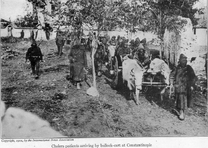
Cholera was common among the soldiers of the combatant nations
Though the Balkan allies had fought together against the common enemy, that was not enough to overcome their mutual rivalries. The Second Balkan War broke out on 16 June 1913 when Bulgaria attacked its erstwhile allies in the First Balkan War, Serbia and Greece, while Montenegro, Romania and the Ottoman Empire intervened later against Bulgaria. When the Greek army entered Thessaloniki in the First Balkan War ahead of the Bulgarian 7th division by only a day, they were asked to allow a Bulgarian battalion to enter the city. Greece accepted in exchange for allowing a Greek unit to enter the city of Serres.
The Bulgarian unit that entered Thessaloniki turned out to be a 48,000-strong division instead of the battalion, something which caused concern among the Greeks, who viewed it as a Bulgarian attempt to establish a condominium over the city. In the event, due to the urgently needed reinforcements in the Thracian front, the Bulgarian Headquarters were soon forced by necessity to remove its troops from the city (while the Greeks agreed by mutual treaty to remove their units based in Serres) and transport them to Dedeağaç (modern Alexandroupolis), but besides the agreement it left behind a battalion that started fortifying its positions.
Greece had also allowed the Bulgarians to control the stretch of the Thessaloniki-Constantinople railroad that lay in Greek-occupied territory, since Bulgaria controlled the largest part of this railroad towards Thrace. After the end of the operations in Thrace and in confirmation to the Greek concerns, Bulgaria not satisfied with the territory it controlled in Macedonia, immediately asked Greece to relinquish its control over Thessaloniki and the land north of Pieria, effectively to hand over all Aegean Macedonia. These unacceptable demands together with the Bulgarian refusal to demobilize its army after the Treaty of London had ended the common war against the Ottomans, alarmed Greece, which decided also to maintain its army's mobilization.

Boundaries on the Balkans after the First and the Second Balkan War (1912–1913)
Similarly, in northern Macedonia, the tension between Serbia and Bulgaria due to later aspirations over Vardar Macedonia generated many incidents between the nearby Armies, prompting Serbia to maintain its army's mobilization. Serbia and Greece proposed that each of the three countries reduce its army by one fourth, as a first step to facilitate a peaceful solution but Bulgaria rejected it. Seeing the omens Greece and Serbia started a series of negotiations and signed a treaty on May 19/June 1, 1913. With this treaty, a mutual border was agreed between the two countries, together with an agreement for mutual military and diplomatic support in case of a Bulgarian or/and Austro-Hungarian attack. Tsar Nicholas II of Russia, being well informed, tried to stop the upcoming conflict on June 8, by sending an identical personal message to the Kings of Bulgaria and Serbia, offering to act as arbitrator according to the provisions of the 1912 Serbo-Bulgarian treaty. But Bulgaria by making the acceptance of Russian arbitration conditional, in effect denied any discussion, caused Russia to repudiate its alliance with Bulgaria (see Russo-Bulgarian military convention signed 31 May 1902).
The Serbs and the Greeks had a military advantage in the eve of the war because their armies confronted comparatively weak Ottoman forces in the First Balkan War and suffered relatively light casualties while the Bulgarians were involved in heavy fighting in Thrace. The Serbs and the Greeks had time to fortify their positions in Macedonia. The Bulgarians also held some advantages controlling internal communication and supply lines.
On 16 June 1913 General Savov under the direct orders of the tsar Ferdinand I, issued attacking orders against both Greece and Serbia without consulting the Bulgarian government and without any official declaration of war. During the night of June 17, 1913 they attacked the Serbian army at Bregalnica river and then the Greek army in Nigrita. The Serbian army resisted the sudden night attack, while most of soldiers did not even know who they are fighting with, as Bulgarian camps were located next to Serbs and were considered allies. Montenegro's forces were just a few km away and rushed also to the battle. The Bulgarian attack was halted.
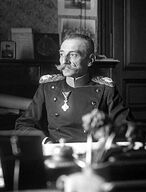
Peter I of Serbia
The Greek army was also successful. Retreating according to the plan for two days while Thessaloniki was cleared of the remaining Bulgarian regiment. Then the Greek army counter-attacked and defeated the Bulgarians at Kilkis-Lahanas, after which the mostly Bulgarian town was destroyed. However, the Greek army's pace was not quick enough as to prevent the massacre of Greek peaceable inhabitants at Nigrita, Serres, Drama and Doxato. The Greek army then divided their forces and advanced in two directions. Part proceeded east and occupied Western Thrace. The rest of the Greek army advanced up to the Struma River valley, defeating the Bulgarian army in the battles of Doiran and Mt. Beles and continued its advance to the north towards Sofia. In the Kresna Straits the Greeks were ambushed by the Bulgarian 2nd and 1st Army newly arrived from the Serbian front that had already taken defensive positions there following the Bulgarian victory at Kalimanci.
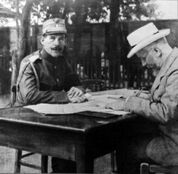
Constantine I of Greece and Prime Minister Eleftherios Venizelos at the Greek GHQ during the Second Balkan War
By 30 July the Greek army outnumbering by the now counter-attacking Bulgarian Armies attempting to encircle the Greeks in a Cannae-type battle applying pressure on their flanks. The Greek army resisted successfully however, launching local counter-attacks. The battle was continued for eleven days, between July 29 and August 9 over 20 km of a maze of forests and mountains with no conclusion. The Greek King, seeing that the units he fought were from the Serbian front, tried to convince the Serbs to renew their attack, as the front ahead them was now thinner, but the Serbs, rejected it. By then, news came for the Romanian success towards Sofia and its imminent fall. After that, Constantine realizing the aimless of the continuation of the counterattack agreed to Eleftherios Venizelos' proposal and accepted the Bulgarian request for armistice as this had been communicated through Romania.
Romania had raised an army and declared war on Bulgaria on June 27 as it had from June 15 officially warned Bulgaria that it will not remain neutral in a new Balkan war, due to the Bulgaria's refusal to cede the fortress of Silistra as promised before the First Balkan war in exchange for the Romanian neutrality. They encountered little resistance and by the time the Greeks accepted the Bulgarian request for armistice they had reached Vrazhdebna, 7 miles from the center of Sofia.
Seeing the military position of the Bulgarian army the Ottomans decided to intervene. They attacked and finding no opposition, managed to recover the eastern Thrace with its fortified city of Adrianople, regaining a land mass in Europe which was only slightly larger than the present-day European territory of the Republic of Turkey.
Second Mexican-American War[]
See Also: Point of Divergence
In 1910, the 80-year-old Porfirio Díaz decided to hold an election for another term; he thought he had long since eliminated any serious opposition. However, Francisco I. Madero, an academic from a rich family, decided to run against him and quickly popular support, despite his arrest and by Díaz.
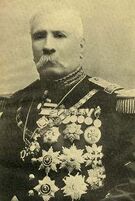
Porfirio Díaz
When the official election results were announced, it was declared that Díaz had won reelection almost unanimously, with Madero receiving only a few hundred votes in the entire country. This fraud by the Porfiriato was too blatant for the public to swallow, and riots broke out. On November 20, 1910, Madero prepared a document known as the Plan de San Luis Potosí, in which he called the Mexican people to take up weapons and fight against the Díaz government. Madero fleeing, prison on a horse, is shot and killed.
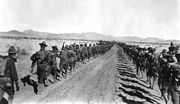
American Troops returning to USA in 1918
Diaz's brutality soon lost him domestic support, and the Wilson Administration actively opposed his regime, for example the naval bombardment of Veracruz.
This bombardment caused Mexico to declare war on the United States of America, and started the Second Mexican-American War. When Diaz died in 1915, Victoriano Huerta was his successor, continuing the war. America, being busy in their own lands, did not enter into the First World War. Without help from the USA, the Allied Powers are defeated in the Hundred Days Offensive, achieving a Central Powers Victory. Although the German Empire rendered aid to Mexico, America managed to have victory in North America, declaring its Manifest Destiny in the Mexican States of Tamaulipas, Coahuila, and Nuevo León.
First World War[]
See Main Article: First World War
The Start of the War[]
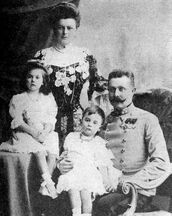
Franz Ferdinand and his wife and daughters
World War I began on July 28, 1914, when Austria-Hungary declared war on Serbia. This seemingly small conflict between two countries spread rapidly: soon, Germany, Russia, Great Britain, and France were all drawn into the war, largely because they were involved in treaties that obligated them to defend certain other nations. Western and eastern fronts quickly opened along the borders of Germany and Austria-Hungary.
The Western and Eastern Fronts[]
The first month of combat consisted of bold attacks and rapid troop movements on both fronts. In the west, Germany attacked first Belgium and then France. In the east, Russia attacked both Germany and Austria-Hungary. In the south, Austria-Hungary attacked Serbia. Following the Battle of the Marne (September 5–9, 1914), the western front became entrenched in central France and remained that way for the rest of the war. The fronts in the east also gradually locked into place.
The Ottoman Empire[]
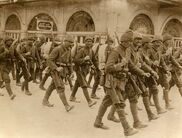
Ottoman Troops
Late in 1914, the Ottoman Empire was brought into the fray as well, after Germany tricked Russia into thinking that Turkey had attacked it. As a result, much of 1915 was dominated by Allied actions against the Ottomans in the Mediterranean. First, Britain and France launched a failed attack on the Dardanelles. This campaign was followed by the British invasion of the Gallipoli Peninsula. Britain also launched a separate campaign against the Turks in Mesopotamia. Although the British had some successes in Mesopotamia, the Gallipoli campaign and the attacks on the Dardanelles resulted in British defeats.
Trench Warfare[]
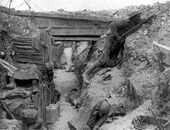
A British trench near the Albert-Bapaume road at Ovillers-la-Boisselle, July 1916 during the Battle of the Somme. The men are from A Company, 11th Battalion, The Cheshire Regiment.
The middle part of the war, 1916 and 1917, was dominated by continued trench warfare in both the east and the west. Soldiers fought from dug-in positions, striking at each other with machine guns, heavy artillery, and chemical weapons. Though soldiers died by the millions in brutal conditions, neither side had any substantive success or gained any advantage.
The United States’ Neutrality and Russia’s Exit[]
In early April, the United States fighting with Mexico, did not declare war at Germany by attacks upon the Lusitania in the Atlantic. Then, in November, the Bolshevik Revolution prompted Russia to pull out of the war.
The End of the War and Armistice[]
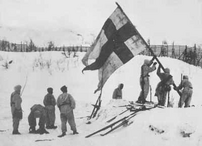
Finnish Royal Troops declaring their new Kingdom
Although both sides launched renewed offensives in 1918 in an all-or-nothing effort to win the war, both efforts failed. The fighting between exhausted, demoralized troops continued to plod along until the Allied lost a number of individual battles and very gradually began to fall back. A deadly outbreak of influenza, meanwhile, took heavy tolls on soldiers of both sides. Eventually, the governments of both France and Belgium began to lose control as both countries experienced multiple mutinies from within their military structures.
The war ended in the late fall of 1918, after the member countries of the Allied Powers signed armistice agreements one by one. Great Britain was the last, signing its armistice on November 11, 1918. As a result of these agreements, Russia was broken up into several smaller countries and a smaller Russia. France and Belgium, under the Treaty of Topkapi, were severely punished with hefty economic reparations, territorial losses, and strict limits on its rights to develop militarily. Great Britain and Portugal lost most of their colonial empires in South Africa.
Bolshevik Revolution[]
Russian Revolution of 1917[]

Propaganda showing Lenin and the Bolsheviks
During World War I, Tsarist Russia experienced famine, Territorial lost, and economic collapse. The demoralized Russian Army suffered severe military setbacks, and many soldiers deserted the front lines. Dissatisfaction with the monarchy and its policy of continuing the war grew. Tsar Nicholas II abdicated in February of 1917 following widespread rioting in Petrograd.
A provisional government was installed at that time, led first by Prince Georgy Yevgenyevich Lvov, then by Aleksandr Kerensky, but it maintained its commitment to the war being part of Entente, despite widespread calls of some political forces for Russia to seek a peaceful settlement. The provisional government also was postponing to enact land reforms demanded by the peasantry, who accounted for over eighty percent of the population.
Within the military, mutiny and desertion were pervasive among conscripts; the intelligentsia was disaffected over the slow pace of reforms; poverty was worsening; and income disparities and inequality were growing while the provisional government grew more and more autocratic and appeared on the verge of succumbing to a military junta. Deserting soldiers returned to the cities and gave their weapons to angry socialist factory workers. Conditions in urban areas were fertile ground for revolution.
Between February and October 1917, the power of the provisional government was consistently questioned. A system of 'dual power' emerged, for while the Provisional Government held nominal power, they were increasingly opposed by the Petrograd Soviet, controlled by the Mensheviks and Socialist Revolutionaries, both democratic socialist parties politically to the right of the Bolsheviks. The Soviet chose not to force further changes in government due to their belief that the February Revolution was Russia's bourgeois democratic revolution which would be tasked with implementing democratic reforms and would lead in turn to a proletarian revolution. However, they still remained a hugely powerful body.
Failed military offensives in summer 1917 and protests in the capital led to troops being called into cities in late August to restore order. Rather than forcing a peace however, they joined the rioters and the government and military were further disgraced. During this time, support for the Bolshevik party was growing and one of its leading figures, Leon Trotsky was elected chair of the Petrograd Soviet, who was also directly responsible for the defence of the city, and therefore, the city's military forces.

A scene from the July Days. The army has just opened fire on street protesters.
On October 24, the Provisional Government moved against the Bolsheviks, arresting activists and destroying propaganda materials. The Bolsheviks were able to portray this as an attack against the People's Soviet and marched on the Provisional Government, taking control on the 25th October. The Mensheviks and the right-wing of the Socialist Revolutionaries, outraged at the acts carried out in the name of the Soviet, left the body, leaving it in the control of the Bolsheviks and remaining Left Socialist Revolutionaries. On the October 25, 1917 the Sovnarkom was established to be later formalized by the Russian Constitution of 1918 as the administrative arm of the Congress of Soviets; by January 6, 1918 the VTsIK had ratified the dissolution by the Bolsheviks of the Russian Constituent Assembly, which was intended to establish non-Bolshevik Russian Democratic Federative Republic as the permanent form of government established at its Petrograd session held from January 5 to January 6, 1917.
The Russian Civil War[]
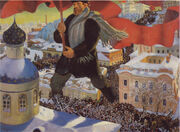
Bolshevik (1920), by Boris Kustodiev.
Prior to the revolution, the Bolshevik doctrine of democratic centralism argued that only a tightly-knit and secretive organization could successfully overthrow the government; after the revolution, they argued that only such an organization could prevail against foreign and domestic enemies. Fighting the civil war would actually force the party to put these principles into practice.
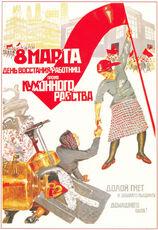
The 1932 Soviet poster symbolizing the reform of "old ways of life" is dedicated to liberation of women from traditional role of the oppressed housekeeper. The text reads: "8th of March is the day of the rebellion of the working women against the kitchen slavery". "Say NO to the oppression and Babbittry of the household work!".
Arguing that the revolution needed not a mere parliamentary organization but a party of action which would function as a scientific body of direction, a vanguard of activists, and a central control organ, the Tenth Party Congress banned factions within the party, initially intending it only to be a temporary measure after the shock of the Kronstadt Rebellion. It was also argued that the party should be an elite body of professional revolutionaries dedicating their lives to the cause and carrying out their decisions with iron discipline, thus moving toward putting loyal party activists in charge of new and old political institutions, army units, factories, hospitals, universities, and food suppliers. Against this backdrop, the nomenklatura system would evolve and become standard practice.
In theory, this system was to be democratic since all leading party organs would be elected from below, but also centralized since lower bodies would be accountable to higher organizations. In practice, "democratic centralism" was centralist, with decisions of higher organs binding on lower ones, and the composition of lower bodies largely determined by the members of higher ones. Over time, party cadres would grow increasingly careerist and professional. Party membership required exams, special courses, special camps, schools, and nominations by three existing members.
In December 1917, the Cheka was founded as the Bolshevik's first internal security force. Later it changed names to GPU, OGPU, MVD, NKVD and finally KGB. During the Civil War, on September 5, 1918 the Cheka was given responsibility for targeting remnants of the Tsarist regime, opposing parties of the left such as the Social Revolutionaries and other anti-Bolshevik groups such as the Cossacks, the policy of Red Terror. Said Felix Dzerzhinsky, first head of the Cheka, June, 1918 in the newspaper, New Life: "We represent in ourselves organized terror - this must be said very clearly - such terror is now very necessary in the conditions we are living through in a time of revolution,"
